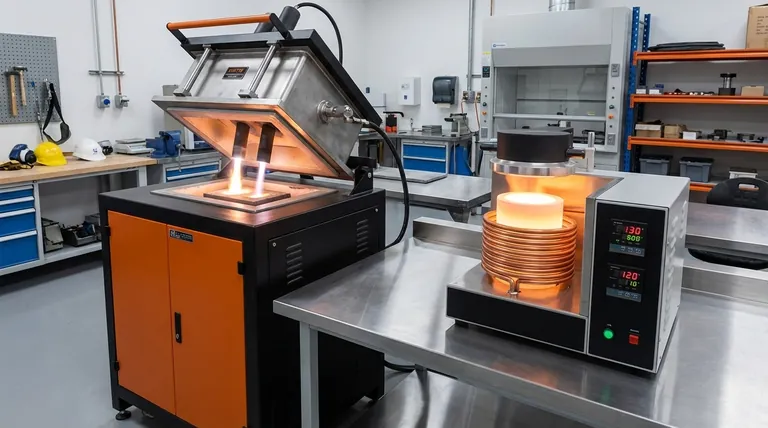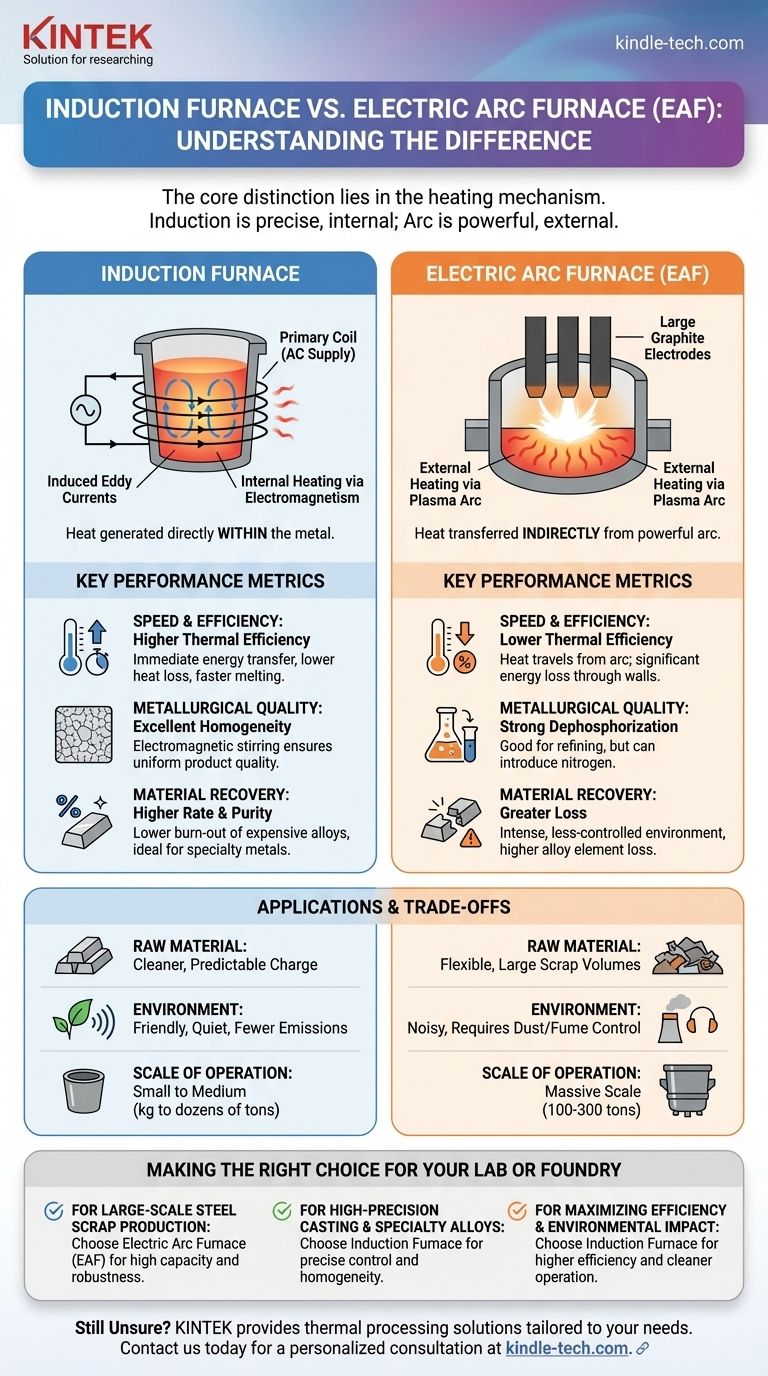The fundamental difference is not between "electric" and "induction," as an induction furnace is a specific type of electric furnace. The common comparison is between the Electric Induction Furnace and the Electric Arc Furnace (EAF). An induction furnace uses an electromagnetic field to generate heat directly within the metal, while an electric arc furnace uses a powerful electric arc between electrodes to melt the metal from the outside.
The core distinction lies in the heating mechanism. Induction is a precise, internal heating method ideal for quality control, while the electric arc is a powerful, external heating method built for large-scale melting. Choosing the right one depends entirely on your material, scale, and desired metallurgical outcome.

The Fundamental Difference: How Heat Is Generated
To understand the practical differences in performance, you must first grasp how each furnace generates heat. They operate on entirely different physical principles.
The Induction Furnace: Internal Heating via Electromagnetism
An induction furnace operates like a transformer. A primary coil, connected to an AC supply, surrounds the crucible containing the metal charge.
This creates a powerful, rapidly changing magnetic field that induces electrical eddy currents directly within the metal. The metal's natural resistance to these currents generates intense, uniform heat from the inside out.
The Electric Arc Furnace (EAF): External Heating via Plasma Arc
An electric arc furnace uses large graphite electrodes to create a high-energy electric arc—a form of plasma—that strikes the metal charge.
This arc generates immense heat, which is then transferred indirectly to the metal, often through a layer of molten slag. This is a brute-force method designed to melt large quantities of material quickly.
Comparing Key Performance Metrics
The difference in heating methods directly impacts efficiency, material quality, and operational control.
Speed and Thermal Efficiency
The induction furnace is significantly more efficient. Because heat is generated directly within the metal, energy transfer is immediate and contained, leading to faster melting times and lower heat loss.
The EAF has lower thermal efficiency. Heat must travel from the external arc to the metal, and a substantial amount of energy is lost through the furnace cover and walls.
Metallurgical Quality and Control
The induction process creates a natural electromagnetic stirring effect. This constant motion ensures the molten metal is highly uniform, resulting in a homogeneous product quality.
The EAF is stronger in dephosphorization (removing phosphorus from the steel), a critical refining step. However, it can also introduce more nitrogen into the final product.
Material Recovery and Purity
Induction furnaces have a higher metal recovery rate and a lower burn-out ratio for expensive alloy elements. This makes them ideal for producing high-value specialty alloys.
The intense, less-controlled environment of an EAF can lead to greater loss of alloy elements.
Understanding the Trade-offs and Applications
Neither furnace is universally "better." They are specialized tools designed for different industrial scales and materials.
Raw Material Flexibility
EAFs are the workhorses of modern steel recycling. They excel at melting enormous volumes of scrap steel, including lower-quality or less-sorted materials.
Induction furnaces perform best with cleaner, more predictable charge materials. They are perfectly suited for foundries that remelt known alloys or pre-production scrap where purity is paramount.
Environmental and Operational Impact
The induction furnace is generally considered more environmentally friendly. It operates more quietly and produces fewer emissions and less dust than an EAF.
EAFs are known for generating significant noise and requiring extensive dust collection and fume-handling systems.
Scale of Operation
EAFs are built for massive scale, with capacities often reaching 100-300 tons. They are the cornerstone of "mini-mills" that produce structural steel and other commodity products.
Induction furnaces typically operate at smaller to medium scales, from a few kilograms to several dozen tons, making them the standard choice for foundries and specialty metal producers.
Making the Right Choice for Your Application
Your final decision must be driven by the specific demands of your process.
- If your primary focus is large-scale production from steel scrap: The Electric Arc Furnace is the industry standard for its high capacity and robust ability to process diverse raw materials.
- If your primary focus is high-precision casting and specialty alloys: The Induction Furnace is superior for its precise temperature control, excellent material homogeneity, and high alloy recovery.
- If your primary focus is maximizing efficiency and minimizing environmental impact: The Induction Furnace offers a clear advantage with its higher thermal efficiency and cleaner, quieter operation.
Understanding the core heating principle—internal induction versus external arc—is the key to selecting the right tool for your specific metallurgical goal.
Summary Table:
| Feature | Induction Furnace | Electric Arc Furnace (EAF) |
|---|---|---|
| Heating Method | Internal (electromagnetic induction) | External (electric arc) |
| Best For | High-precision casting, specialty alloys | Large-scale steel scrap melting |
| Efficiency | High thermal efficiency | Lower thermal efficiency |
| Scale | Small to medium (kg to dozens of tons) | Large (up to 100-300 tons) |
| Material Quality | Excellent homogeneity, high alloy recovery | Strong dephosphorization, can introduce nitrogen |
| Environment | Quieter, fewer emissions | Noisier, requires dust/fume control |
Still Unsure Which Furnace is Right for Your Lab or Foundry?
Choosing between an induction furnace and an electric arc furnace is a critical decision that impacts your product quality, efficiency, and bottom line. KINTEK, your trusted partner in lab equipment and consumables, can help you navigate this choice.
We specialize in providing the right thermal processing solutions for your specific laboratory or production needs. Whether you're melting specialty alloys with precision or require robust equipment for larger-scale operations, our experts are here to ensure you get the performance and results you need.
Contact us today using the form below for a personalized consultation. Let's discuss your application and find the perfect furnace solution for you.
Visual Guide

Related Products
- Vacuum Heat Treat Furnace and Levitation Induction Melting Furnace
- 1400℃ Laboratory Quartz Tube Furnace with Alumina Tube Tubular Furnace
- Vertical Laboratory Quartz Tube Furnace Tubular Furnace
- Laboratory Muffle Oven Furnace Bottom Lifting Muffle Furnace
- 1700℃ Laboratory Quartz Tube Furnace with Alumina Tube Tubular Furnace
People Also Ask
- Why do you heat treat in a vacuum? Achieve Perfect Surface Finish and Material Integrity
- What are the five basic heat treatment processes of metals? Master Annealing, Hardening & More
- What is low temperature vacuum? A Guide to Precision, Oxide-Free Thermal Processing
- How does heat treatment process work? Tailor Material Properties for Your Application
- What is the process of vacuum quenching? Achieve Superior Hardness with a Pristine Surface Finish



















